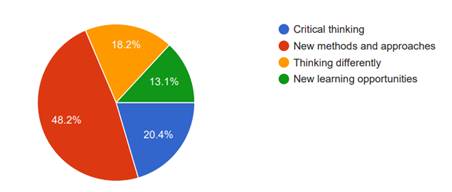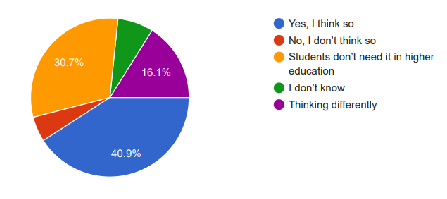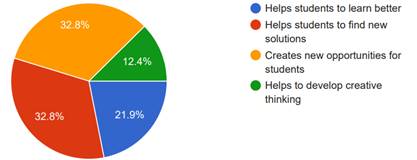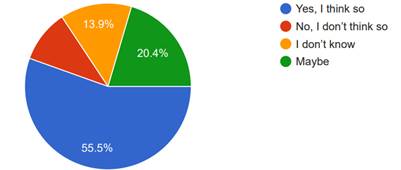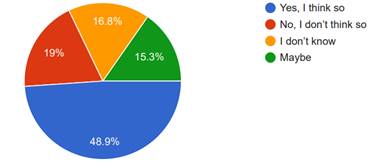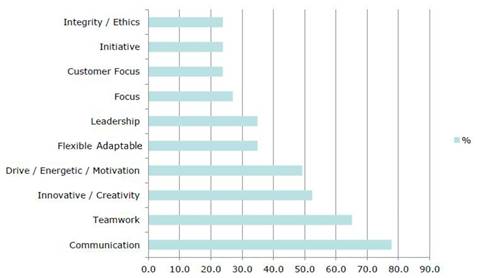Introduction
Creativity implies more than imagination or fancy, it signifies and brings along novel, original and valuable outcomes for the individual or society. While the imaginative person is a dreamer, the creative person moves the world forward. To this effect, (s)he needs to have a powerful background of information and education, a powerful basis of differentiated assessment systems, whereby the production of values should be possible and assessable (Suciu, 2014). Smith et al. (2014) establish that sometimes learners find it hard to externalize questions or even to admit they have questions. They are embarrassed to be wrong or admit to not (already) knowing. They avoid the necessary actions to find deeper answers in themselves or based on external sources. Possibility thinking influences our ability to find and solve problems and come up with original ideas. A possibility thinker is constantly looking to find new ways of thinking about the world.
Although previous research have been conducted relating creativity and higher education there are still gaps. For example, Alencar et al., (2017) addressed the changes occurring in modern society, which require the rapid improvement of the field of education, but the determination of new educational goals where not analyzed in detail. Also, the system-active approach, which is the basis of the development of new educational standards, is not sufficiently analyzed.
In the work of de Alencar & de Oliveira (2016), who conducted fundamental research in the relevant field, it is substantiated with strong arguments that the main strategic goal of the modern education system is the formation of a personality with creative thinking and high scientific abilities. It is clear that this goal cannot be achieved by traditional educational methods. New approaches, new semantic tasks are needed to develop students' intellectual skills. As a result, this means a change in the method of education, that is, a transition from imparting knowledge to acquiring that knowledge by the students themselves.
Although the directions mentioned in the research by Hernández-Torrano & Ibrayeva (2020) are widely investigated, the research covers only the period 1975-2019, so updates for the last 3 years are not reflected in the article. The article of Akpur (2020) is one of the main researches related to the topic we are investigating in Turkish sources. Although state-of-the-art methods related to increasing the creative qualities of the requirements are investigated, the results are focused and defined only for those working in the academic sphere.
Considering the above, the goal of this paper is analyze student creativity in higher education and outlines its importance. For this study, a systematic literature review was conducted in order to evaluate and analyze all available evidence relevant to our study objective. In an initial step, articles for review were identified by searching several scientific databases from EBSCO, SCOPUS and etc. These databases were selected because they are the main databases in the field of education, pedagogy, psychology and social sciences. Studies included in the review met the following criteria: (1) Scientific approaches by different authors on various journals in the English language; (2) discussion of their interrelationship; and (3) analyzing degree creativity in classroom. As a relevant overview of the particular research question was wanted, articles published in any period of time were eligible for inclusion. Also, survey questionnaires were used for developing the study and a comparative analysis method was used when analyzing between different arguments. Finally statistical analysis was used to obtain information from data.
A total number of 137 people took part in the survey, 60% of them women and 40% of them men. Among the respondents, the number of people aged 18-21 and 22-25 was approximately the same (36-39%). One of the factors that affect the specificity of our results is the fact that the majority of respondents have higher education (67%). Also, an experimental study was conducted with the participation of high school students in several schools. Students of grades 9-10-11 were informed in advance. Finally, due to ethical issues the survey was conducted in completely anonymous conditions.
Development
Literature review
Creativity is coming from the Latin word “create” and it is meaning to produce something. The great Latin poet Horatio believed that poets and painters have talent to create something new. Gaspar and Mabic (2015) pointed out that modern approach to creativity has started with theory of Graham Walas published in his book “Art of Thought” in 1926. He explained model for the four stages of creativity: preparation, incubation, illumination, and verification. However, formal start of scientific research of creativity was imputed to J.P. Guilford. Guilford made an important contribution to understanding of creativity when he distinguished between convergent and divergent thinking processes. Clarkson (2005) has mentioned that there are many traits which have been associated with creativity, such as divergent thinking, introversion, self-esteem, tolerance for ambiguity, willingness to take risks, behavioral flexibility, emotional variability, ability to absorb imagery, and even the tendency to neurosis and psychosis. According to Gomez (2007) all individuals are to some extent creative, although some are much more creative than others are. While a small part of this difference may be due to heredity, a large part likely results from the failure of individuals to express their creative potential. In fact, many essential attributes of creativity are discouraged in the typical college classroom.
Answering the question “What is creativity?” Roy (2019) states that creativity is a learning attitude that requires knowledge. To be innovative with ideas and concepts there is a requirement to have some basic concepts and knowledge. Creative thinking can be defined as the thinking that enables students to use their imagination to generate ideas, questions and hypotheses, experiment with alternatives and to evaluating their own and their peersʼ ideas and final products. On the other hand Fields and Bisschoff (2013) highlighted that creativity occurs on the right side of the brain when ideas are sparked, but to make creativity useful requires both divergent thinking (generating many unique ideas) and convergent thinking (combining those ideas into the best result).
Robinson (2006) says that creativity is an essential aspect for learning, since learning takes us into a future that we cannot yet grasp. He argues there is a need to promote divergent thinking in diverse and dynamic learning spaces. We need educational spaces that acknowledge human diversity and that privilege and exploit such diversity to develop our creative capital. If you ask any group of higher education teachers in the UK, ‘what does being creative mean to you?’ you will get a set of responses that embrace the following ideas:
originality and individuality.
being imaginative, generating new ideas, thinking outside the boxes we normally inhabit, looking beyond the obvious, seeing the world in different ways.
making new things.
doing things no one has done before.
doing things that have been done before but differently.
experimenting and taking risks (Jackson, 2013).
Cannatella (2004) mentions that the need for creativity is biologically, physically, and psychologically an essential part of human nature, and that it is necessary for human- reproduction, growth and cultural striving. Plucker (1998) argues that the concept of creativity, although a key topic in current debate on educational innovation, is not a well- defined in scientific research and within the context of education. Guilford stated that “a creative act is an instance of learning ... [and that] a comprehensive learning theory must take into account both insight and creative activity”. In this regard, Guilford (1967) suggested that transformations of information are a key to understanding insight. These transformations are found in the content categories of Guilford’s SI model (Guilford, 1975) and can occur in both convergent and divergent productions. At that time, the relation between information and insight still needed to be addressed. Therefore, there have been attempts in the past 20 years to expand our understanding of insight.
Reid and Petocz (2004) say that creativity is viewed in different ways in different disciplines: “innovation” in business “entrepreneurship”; in mathematics it is sometimes equated with “problem-solving”, and in music it is “performance or composition”. A creative product in different domains is measured against the norms of that do- main, its own rules, approaches and conceptions of creativity.
Psychologist de Bono (1995) believes that creativity is the most important human resource of all. Without creativity, there would be no progress, and we would be forever repeating the same patterns. Creativity specifically has become a critical consideration, because “creativity becomes a force of great value when it is applied to causes that benefit humankind and the world at large” (Fields & Bisschoff, 2013). Creativity is the result of critical thinking and as well as out of box thinking. Creativity is a skill, a knowledge and an attitude. Some might say it is core to learning and should be taught as a discrete subject, others that it is domain-specific only, while others argue it already is taught through the creative arts. All such positions have some validity to some extent (Roy, 2019).
Gaspar & Mabic (2015) emphasize that higher education has been paying attention to the creativity when facing with large economic, cultural and other macro-environmental challenges which are changing role of universities, from classical research universities (“ivory towers”) to entrepreneurial universities in the way that they not only became autonomous in their decisions, but also in the way that they developed and implemented new research and transfer relationships within their respective regions. In this regard, creative processes can be encouraged in all instructional activities. Creative teaching could be said to consist of setting up a learning environment that encourages students to see the essence as well as the detail of the subject, to formulate and solve problems, to see the connectedness and interrelations between diverse areas, to take in and react to new ideas, and to include the elements of surprise in their work (Reid & Petocz, 2004). However, in the believe of Jackson (2013) the problem is not that creativity is absent but that it is omnipresent subsumed within analytic ways of thinking that dominate the academic intellectual territory.
Feldhusen & Treffinger (1985) provided several recommendations for establishing a classroom environment conducive to creative thinking:
Support and reinforce unusual ideas and responses of students.
Use failure as a positive to help students realize errors and meet acceptable standards in a supportive atmosphere.
Adapt to student interests and ideas in the class- room whenever possible.
Allow time for students to think about and develop their creative ideas. Not all creativity occurs immediately and spontaneously.
Create a climate of mutual respect and acceptance between students and between students and teachers, so that students can share, develop, and learn together and from one another as well as independently.
Be aware of the many facets of creativity besides arts and crafts: verbal responses, written responses both in prose and poetic style, fiction and nonfiction form. Creativity enters all curricular areas and disciplines.
Encourage divergent learning activities. Be a resource provider and director.
Listen and laugh with students. A warm, supportive atmosphere provides freedom and security in exploratory thinking.
Allow students to have choices and be a part of the decision-making process. Let them have a part in the control of their education and learning experiences.
Let everyone get involved and demonstrate the value of involvement by supporting student ideas and solutions to problems and projects.
Smith et al. (2014) writes that according to McWilliam & Dawson (2008) there are a set of paradoxes designed to inform the high level design of replicable pedagogical environments infused with apparently contradictory imperatives but creating a rich climate to foster and evoke creative outcomes. Smith says that they have interpreted the McWilliam and Dawson paradoxes briefly as:
Connectivity with diversity - an environment where learners are connected within a local community but with awareness of a larger world of potential team members sharing cognate interests.
Co-invention/co-creation with separation - an environment in which the rules of self- management and self-regulation are understood but one in which authentic and synergistic learning, is promoted.
Leading and following -an environment where team members share collective responsibility for leadership.
Enhancing constraints and removal of inhibitors - an environment that minimizes control while providing scaffolded opportunities to enable team members to optimize their own and team performances.
Explaining less and welcoming error - an environment with flattened control, recognizing errors will be made but utilizing them as learning opportunities.
Also, Barrett & Donnelly (2018) offered some ideas about student creativity, drawing on:
philosophical and theoretical understandings of creativity
starting points for creativity
the four interweaving elements of creativity
perspectives on the outcomes of creativity.
Educational process primarily needs to set a target on new thinking and creativity for it to make education have the real effect on the society. The problem of creativity in higher education is that it is not chronic, in the sense that most teachers and decision makers believe that there is an issue to be resolved. The problem is more a sense of dissatisfaction with a higher education world that seems, at best, to take creativity for granted, rather than celebrates the contribution that creativity makes to academic achievement, self-expression and personal wellbeing (Jackson, 2013). Then, Jackson (2013) establishes that the most important argument for higher education to take creativity in students’ learning more seriously, is that creativity lies at the heart of performing, learning and developing in any context, and the highest levels of performance involve the most creative acts of all.
According to Gomez (2007) for many years, educators also have viewed creative thinking as a process that could only be pursued on an individual basis. Recognizing the innate developmental quality of creativity, educators placed relatively little emphasis on furthering and enhancing creativity through group-teaching methods until Osborne and his associates developed the brain- storming technique for sales personnel in the 1950s and early 1960s.
Smith et al., (2014) write we need a strong and compelling argument to overcome the risk aversion in steps away from safety and conformity towards experimentation, curiosity, and creativity. We offer that self- efficacy and a high level of internal locus of control is likely to influence the approach of both teachers and learners to creativity. We also suggest the design of learning spaces and activities framed by a sound pedagogic rationale for ‘good learning’ could be helpful in promoting creativity.
Runco and Chand’s study suggested that motivation is important for creative thinking and that, in their model, problem finding would facilitate intrinsic motivation in individuals (Runco & Chand, 1995). In other words, students will be more motivated when they choose their own tasks. This would make the task meaningful to the individual. They further suggested that educators devote more time to problem-finding skills to communicate to students that this ability is as important as problem solving. Often, though, extrinsic motivators must be used to foster intrinsic motivation. Of importance is Runco and Chand’s argument that “motivation is dependent on cognitive processes”, such as recognition. Thus, in this brief presentation of Runco and Chand’s model, one can see the complexity of creative thinking (Runco & Chand, 1995).
Gomez (2007) writes that for many years, it was assumed that creativity and intelligence were closely related. The incidence of highly creative individuals, such as Edison, Churchill and Einstein, who at some time experienced difficulty in school, led to a closer examination of the issue some- time during the 1960s. Continuing his thoughts Gomez says that since the late 1960s, these and other conflicting studies have made the issue of creativity and intelligence a controversial one. Perhaps the most prevailing view today is that be- yond a minimum level of intelligence necessary for mastery in a given field, additional intelligence offers no guarantee of a corresponding increase in creativity. The idea that the more intelligent individual is necessarily the most creative person is fallacious.
According to Oral (2006), for many developing countries, creativity remains neglected, whereas in developed countries, educational philosophy and goals rely on student’s enhancement of creativity and self-actualization. For developing countries, integration of creative thinking skills in education is a crucial need for shaping their future orientations and actualizing reforms in political, economic and cultural areas.
Gomez (2007) says that experts on creativity repeatedly stress the importance of discovering both problems and solutions. Original ideas should be actively sought. For example, a student assigned an oral report might be encouraged to add a personal evaluation and to employ any unique techniques that he or she wishes.
As pointed out by Jackson (2013), teacher creativity flourishes where innovators have the resources - especially the time to make change happen. Where the institution's systems and procedures enable rather than hamper their progress. Where they have the respect, emotional support and encouragement of managers and colleagues. Where they can find help when they need it and where they feel their efforts have been valued and they have made a positive difference.
Reflective thinking and evaluation of thoughts is basic to the process of creativity. In general, ideas are evaluated for the purpose of facilitating the problem-solving process at every step. However, continuous evaluation limits the generation of ideas. A suspension of judgment enables one to further examine seemingly wild or impossible ideas. Wrong ideas may be right in the final analysis. Emphasis shifts from the validity of a particular point to its usefulness in producing new arrangements or patterns (Gomez, 2007). But you don't have to be an expert to be creative: we all have the potential to be creative in the contexts that form our lives. We might therefore substitute the word 'capability' for 'expertise' to make this model more relevant to students (Jackson, 2013).
Gaspar and Mabic (2015) conducted a survey at University of Mostar on creativity. The research was conducted on a convenience sample of teachers and students at different faculties of the University of Mostar. The results of research show that there are statistically significant differences for some of the statements, while differences in average grades are obvious for all statements. Both teachers and students think that students should be encouraged on creativity. It means that during lectures teachers should use new methods of learning and accept that it could be significant difference between their and students’ opinions about the same thing. It is interesting to notice that both, teachers and students, think that teachers have main role in encouraging students to creativity and that efficiency of encouragement is dependent on personal characteristics of teachers. Also, it is necessary to point out differences in grades for statements “Each problem has unique solution” and “To successfully pass the exam the student needs to answer the question exactly as it is stated in literature”. Since the classical - ex-cathedra approach in teaching process is still prevailing; one could expect higher agreement of teachers. Strange, but students agreed more with those statements. It is necessary to stress that the level of agreement is relatively low for both of them (average grades are about 20.
Survey analysis results
When students were asked about the meaning of creativity in higher education, only 48% said that creativity was in line with the new methods and approaches. 20% of them thought it was about critical thinking, which is one of the interesting approaches (Figure 1.)
After that, the respondents were asked the question of the importance of creativity in higher education. A higher percentage of participants noted the importance of this, however, it is clear that creativity is not fully understood by respondents at some points. (Figure 2.)
For a clearer picture, the next chart asks the reasons for the need for creativity in higher education. In this case, 33% of respondents said that creativity helps students find new solutions. Another 33% said it created new opportunities for students. In fact, 22% of respondents say that creativity helps students learn better. It can be concluded that some respondents, even if they were hesitant to answer questions about the place and role of creativity in higher education, were able to point out how it would help students (Figure 3).
Respondents were asked whether creativity depends on teachers. Among respondents, 56% said that creativity is directly related to the teacher factor while 21% of them think that creativity can be demonstrated with the help of teachers. In fact, this approach is more correct because creativity cannot depend directly on the teacher. The teacher can simply play a guiding role (Figure 4).
In addition, respondents were asked whether creativity depends on students. In this case, 49% of respondents responded positively. This is a more expected answer (Figure 5).
One of the questions raised during the survey was whether the teacher's character had an impact on student creativity. 36% of respondents said that this effect is possible, and 42% of them said that it is even very high (Figure 6).
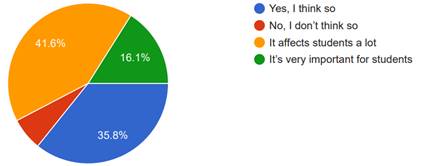 Source: owner elaboration
Source: owner elaborationFig. 6 - Do you think that teachers’ characteristics affect students’ creativity?
Even students sometimes wonder if they should demonstrate their creative skills while studying. Respondents were also asked about this, and 54% of them rightly said that it was necessary during some classes. 15% of respondents noted that the demonstration of creativity is not important for all classes, which is a very correct approach. So there are lessons where it may not be necessary to be creative (Figure 7).
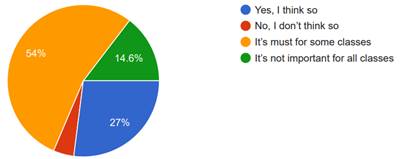 Source: owner elaboration
Source: owner elaborationFig. 7 - Do you think that students have to demonstrate their creativity in all classes?
Respondents were asked whether it is necessary for teachers to encourage students to be creative. 46% of participants think that this is even more important. Indeed, the more you work on creativity, the more it develops. It is gratifying that 42% of respondents agree with the idea of encouraging creativity by teachers. In general, 88% of respondents have positive answers for this question. If we look at the questionnaire and compare our previous answers, we can see that although they could not answer with certainty what the creative concept is, in terms of application, the participants correctly measured its value (Figure 8).
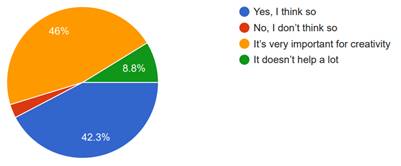 Source: owner elaboration
Source: owner elaborationFig. 8 - Do students need to be encouraged by instructors/teachers for creativity?
At the end, the respondents were asked about their attitudes towards recognizing student creativity as innovation. The analysis of the answers shows that 52% of respondents understand creativity as an innovation. 32% of participants agree that there is such a possibility. In fact, creativity is an internal skill on the one hand, on the other hand, it needs to be constantly developed. Most importantly, developing creativity plays a positive role in the development of education and work process (Figure 9).
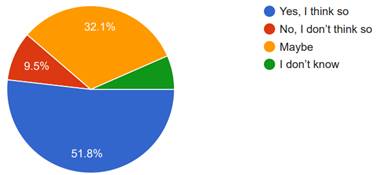 Source: owner elaboration
Source: owner elaborationFig. 9 - Do you think that student creativity can be understood as an innovation?
Student’s creativity for online and traditional classes
The current conditions in which we live have left their mark on higher education. Thus, the traditional form of education that we have become accustomed to over the years has been transferred to online. Undoubtedly, on the one hand, this has allowed teachers and students to learn more about online opportunities, and on the other hand, it has completely changed the format of lessons. Thus, it is clearer and more visible that traditional lessons require the teacher to demonstrate something and require students to work in any project format.
In order to study the mechanism of measuring the quality of students' online learning in higher education, a survey was conducted among teachers (215 participants) working in various specialties in Azerbaijan (Table 1). Looking at these results, it is clear that the vast majority of participants (50%) preferred the issue of forecasting “comparison of student achievement with live or face-to-face classroom conditions”. 22% of them highlighted the issue of student performance in the simulated tasks of real-world activities.
Table 1 - Predictions about how the quality of online learning will be measured.
| Response Options | Number of respondents | Response Rate (%) |
|---|---|---|
| Comparison of student achievement with those in live or face-to-face classroom settings | 108 | 50% |
| Student performance in simulated tasks of real world activities | 45 | 22% |
| Student course evaluations | 19 | 9% |
| Course completion rates | 14 | 6% |
| Course interactivity ratings and evaluations | 7 | 3% |
| Other | 7 | 3% |
| Student placement into jobs | 5 | 2.5% |
| Student satisfaction questionaires | 9 | 4% |
| Computer log data of student usage and activity | 1 | 0.5% |
| Subtotal | 215 | 100% |
| No response | 0 | 0% |
| Total | 215 | 100% |
Source: owner elaboration
However, when asked why traditional teaching is better than online teaching, about 78 percent of respondents said it was more effective in terms of direct communication and 65 percent in terms of teamwork. Unlike traditional lessons, online lessons create such problems. In some cases, the teacher is unable to express his or her opinion, and in some cases, the student's inability to demonstrate their knowledge and skills online can lead to assessment errors. Most importantly, occasional errors on the Internet reduce the quality of online learning compared to traditional learning (Figure 10).
According to the results obtained, every teacher should strengthen the cognitive activity of students in the learning process by activating their intellectual feelings. This is very important. As a result, this kind of activity will serve the development of creative thinking and mind. New pedagogical thinking, integration into world education, humanization of education, in a situation where interactive learning methods are widespread, activation of student thinking emotionally, with the help of mental feelings, is the main psychopedagogical requirement given to the modern lesson. This kind of approach is the main point of this research, and the author believes it will contribute to further research and practical teaching processes in terms of the formation of creative ability in students.
Conclusions
Creativity is the ability to generate new ideas, concepts or original and innovative solutions to a problem or situation. It involves the ability to think differently, to break patterns, and to approach situations from unique and novel perspectives. Creativity can manifest itself in different fields, such as art, science, technology, business and everyday life. Some traits associated with creativity include curiosity, imagination, mental flexibility, the ability to associate seemingly unrelated ideas, and tolerance for ambiguity and uncertainty. However, creativity is not an objective category; rather, it is up to the individual person whether they label another person or product/process as creative or not. Thus, creativity depends on the position of the observer and is a category of subjective observation.
The creativity of students and its development during the years of study in higher education is one of the main problems to overcome, so in this paper its importance is highlighted and previous research on this concept is analyzed. Through the application of a survey, it was found that the majority of the participants think that creativity is about having a different mentality and that its role in higher education is irreplaceable. Thus, creativity creates new opportunities for students. However, teachers have a special role in the development and manifestation of creativity, because teachers must reveal the creativity of students and strive for its development throughout the course. According to the respondents, creativity can sometimes be seen as an innovation in education.
In parallel, the study examined the impact of traditional and online classes on student creativity. Based on the responses, it was concluded that the student is able to demonstrate her skills more clearly due to live communication in traditional classes. Offline classes also focus on group work, which plays a fundamental role in transmitting creativity to students. This is consistent with the difficulty for teachers to be creative in online classes.













